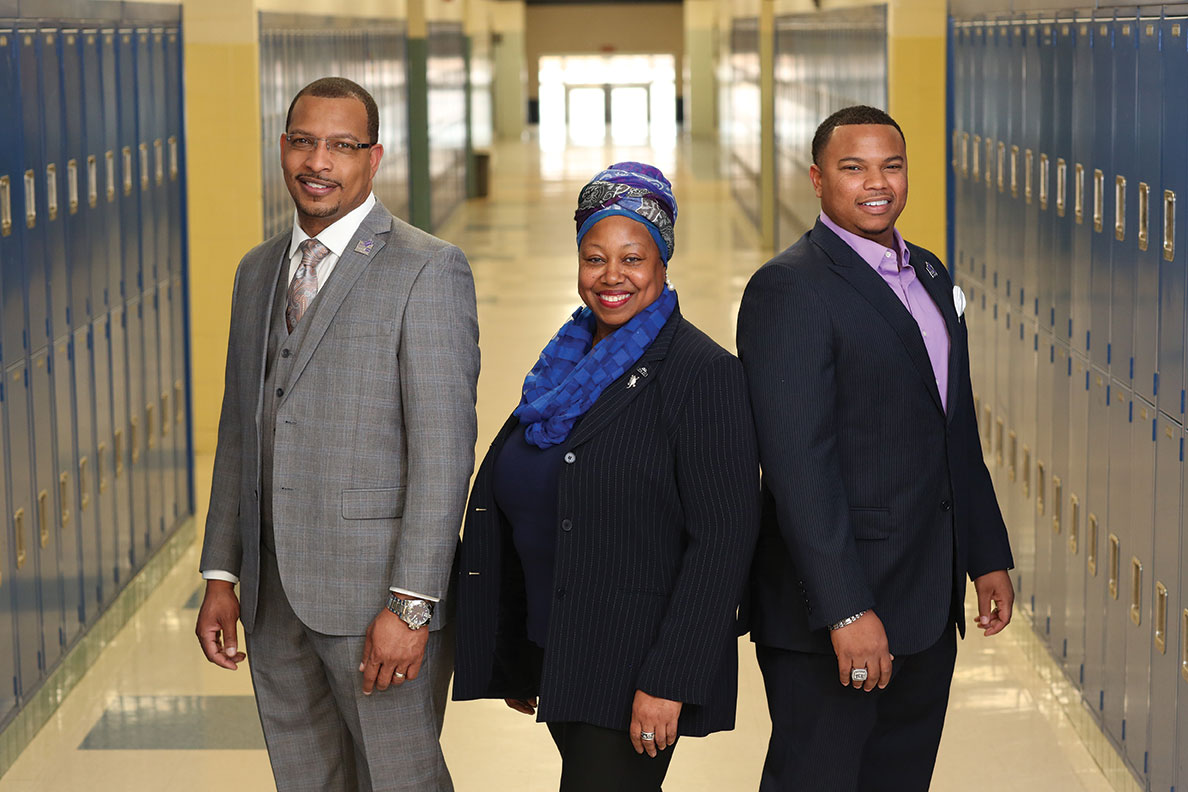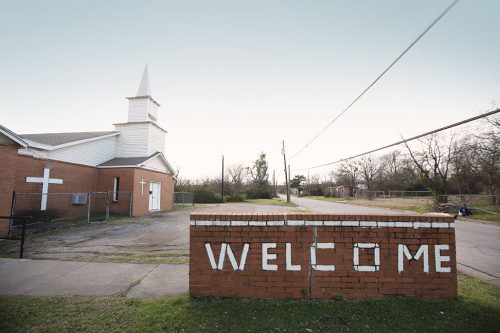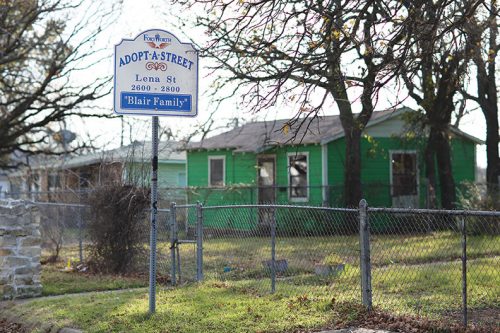
Economic Development in Fort Worth’s Stop Six
Three EMBA graduates bring business expertise to the neighborhood where they grew up.
With crowded Trinity Park at her back, architect R.J. Blair ‘05 EMBA wandered around Fort Worth’s redeveloped 7th Street area looking to capture a photo. Spotting a new fried chicken restaurant, she circled the building and found her shot.
Blair, who is also a city planner, pasted the photograph next to one of a dilapidated and condemned fast food joint in her Stop Six neighborhood in East Fort Worth. In a presentation for Fort Worth’s city council 10 years ago, Blair illustrated the sharp redevelopment contrast, from similar architectural perspectives. “When they asked me what I wanted, I told them this, I want this,” she said in reference to the streetlights, sidewalks, restaurants and stores along bustling 7th Street.
“If you want to attract businesses and stimulate economic development, the environment itself has to be conducive.”
Former Fort Worth City Councilman Donavan Wheatfall
Her request for city funding to plant trees and increase code patrol presence to enforce neighborhood cleanliness rules was “more than reasonable,” said Donavan Wheatfall, a former Fort Worth City Council member who represented the Stop Six area during Blair’s presentation. “If you want to attract businesses and stimulate economic development, the environment itself has to be conducive.”
As a graduate student in TCU’s EMBA program, Blair learned to create nonprofit organizations. Using those skills, she secured a city grant to help spruce up formerly crime-ridden sections of Stop Six during the first phase of her transformation plan for the oft-overlooked neighborhood. Now working with Ray Taylor ‘15 EMBA and Cal Quigley IV ‘15 EMBA, Blair is preparing to start phase two of her visionary project, which requires collaborating with private investors.
Stop Six Natives
Blair, Taylor and Quigley grew up in the Stop Six neighborhood, a historic area about 7 miles east of TCU. They graduated from nearby Dunbar High School.
Blair is a third-generation native of Stop Six. Her late father, Joe Blair, owned a shoe repair business in the once-bustling area. Her maternal grandmother lived through the neighborhood’s 1920s campaign to persuade the Fort Worth school district to educate the area’s mostly African-American children.

Antioch Baptist Church, one of the more than 30 churches in Stop Six. On Sundays the neighborhood can get so crowded that residents often have trouble parking near their homes.
Most businesses in Stop Six are gone now, as are lots of the historic shotgun-style houses. Trees tower over the quiet and relatively safe streets, making the neighborhood feel kind of rural despite being at the midpoint between downtown Fort Worth and AT&T Stadium in nearby Arlington.
In the ‘80s, Blair’s father accompanied her on her move to Boston, where she eventually earned two master’s degrees from the Massachusetts Institute of Technology. She recalled her father’s words during that train trip: “I’m proud of you. However, don’t forget where you come from. And don’t forget your responsibility to return and serve.”
In Boston, Blair learned about community organizing. She learned city planning in China and grant writing in Virginia. While she was away from Fort Worth, the social fabric and modest economy of the once tight-knit Stop Six area unraveled.
When Quigley was at Dunbar High in the mid-1990s, he lost several classmates to gang violence. “I just wanted out of Stop Six,” he said, so he joined the Air Force.
Taylor left the neighborhood after his high school graduation in 1993. He developed a career in telecommunications before becoming a minster at Trinity Harvest Church in Hurst.
Unable to shake the echo of her father’s voice, Blair left Virginia in 2004 and returned to her mother’s house in Stop Six. “I didn’t like what I saw,” she said of her childhood neighborhood. Houses were crumbling. Drug dealers conducted open business in the streets. Terrified elderly residents were virtual prisoners in their homes.
Redevelopment Business
Blair first organized willing neighbors to watch for criminal activity and the illegal dumping that was fouling streets and ruining nearby Wildcat Branch Creek. Forty-year neighborhood resident Rosie Williams signed up as a block captain. “We are trying to be the solution,” she said. “We just want a good, safe neighborhood like anyone else would want.”
“We just want a good, safe neighborhood like anyone else would want.”
Rosie Williams, a Stop Six resident
Next Blair started formulating another action plan. Stop Six needed the city’s help, she said, but residents needed to spruce up the neighborhood to lure businesses. She led by example in repairing and planting flowers at her mother’s home.

The Blair family moved to Lena Street, which they now volunteer to clean, when R.J. was in the eighth grade.
To further help the Stop Six area, Blair successfully lobbied for historic district and urban village designations, which set development guidelines and rewarded homeowners who followed them.
To understand how to work with the business world, Blair enrolled in the EMBA program in the Neeley School of Business. Alongside physicians and corporate managers, she acquired an assortment of business knowledge from accounting to strategy.
While in graduate school, Blair established two nonprofit organizations – one neighborhood association and another for guiding redevelopment. She wrote and received a $1.2 million “Model Blocks” grant from Fort Worth. The city grant funded significant home repairs in Stop Six. It also helped purchase street-topper signs to inspire neighborhood pride.
But full-scale redevelopment for Stop Six called for a bigger team. Kevin Davis, director of external relations for the EMBA program, told Blair to identify future leaders and encourage them to enroll in the program too.
Davis said the neighborhood’s potential leaders would need business skills to rebuild and encourage economic opportunity. A solid foundation in business, he said, would help them “make sure the cause can continue as opposed to it just being about … a bleeding heart.”
Opportunities for Investment
Blair persuaded Taylor, a mentor to her nephew, to seek an EMBA. Taylor recruited Quigley, who was working as a technology instructor at a community college.
“It is just an automatic that those who are from the community, that they come back and serve,” Blair said. “Because then the investment is real. It’s true. It’s ethical.”
“It is just an automatic that those who are from the community, that they come back and serve, because then the investment is real. It’s true. It’s ethical.”
R.J. Blair
Blair said Stop Six residents want normal opportunities within their neighborhood, such as shopping for groceries and walking to handle small errands. Williams said: “Instead of me having to go to Arlington to get something to eat, I would like to do that in my own neighborhood.”
Quigley, Taylor and Blair plan to maximize the networks fostered through the EMBA program. Suzanne Carter, the program’s director, said graduates are doing meaningful work across the city. “We’re seeing more and more attention to that collaborative effort,” she said. “I think it will really bring Fort Worth to a new level over the next decade.”
To design a full-scale development plan for Stop Six, Taylor and Quigley, neither of whom lives in the area, plan to spend more time in their old neighborhood.
“We will start that conversation to figure out how could we come alongside [development efforts] and assist rather than showing up in the community and initiating and creating our own thing,” said Taylor, who is also an executive coach. He plans to offer entrepreneurial workshops to neighborhood residents. “You do need [outside] support and investment,” he said. “But you need to bring the community back to a place where it can stand on its feet and begin to create its own wealth.”

Your comments are welcome
3 Comments
Kudos to all of you for standing up for such an awesome cause!! I am a Stop-Six native and would like to offer help and volunteer as well. Please offer contact information if possible.
Glad to see this crew hard at work on an area in Fort Worth that’s needs inprovements. Would love to help.
How can others become involved in this effort?
Related Reading:
Features
Making Their Case
From confidence to courtroom skills, TCU Mock Trial is shaping futures one case at a time.
Features
As TCU Provost, Floyd Wormley Jr. Leads with Heart, Humor and Hard-Won Wisdom
The academic leader brings clarity, conviction and a scientist’s curiosity shaped by years spent balancing lab work, mentoring and a growing call to serve in higher education.